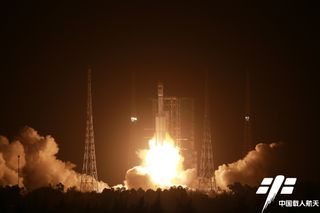
China tested a nuclear-capable hypersonic weapon two months ago, making strides with the technology that surprised and alarmed U.S. officials, according to a media report.
In August, China launched a Long March rocket topped with a hypersonic glide vehicle, which ended up missing its target by just 24 miles (39 kilometers) or so, The Financial Times reported on Sunday (Oct. 17).
The newspaper cited five unnamed people familiar with the launch, two of whom "said the test showed that China had made astounding progress on hypersonic weapons and was far more advanced than U.S. officials realized."
Related: The most dangerous space weapons ever
China has denied the report, claiming that the August mission was nothing to be concerned about.
"This test was a routine spacecraft experiment to verify the reusable technology of spacecraft, which is of great significance for reducing the cost of spacecraft use," Zhao Lijian, a spokesperson for China's Ministry of Foreign Affairs, said during a press briefing on Monday (Oct. 18), CNN reported.
"It can provide a convenient and cheap way for humans to use space peacefully," Zhao said. "Many companies in the world have carried out similar experiments."
Get the Space.com Newsletter
Breaking space news, the latest updates on rocket launches, skywatching events and more!
Hypersonic vehicles are widely viewed as the next frontier in military technology. They fly at least five times faster than the speed of sound and are highly maneuverable, making them more difficult to track and intercept than intercontinental ballistic missiles, which follow predictable trajectories.
China, Russia and the United States are all actively developing and testing hypersonic vehicles. Just two weeks ago, for example, Russia announced that it had test-fired its new Zircon hypersonic missile from a nuclear submarine for the first time. And in September, the U.S. military said that one of its designs, the Hypersonic Air-breathing Weapon Concept (HAWC), achieved hypersonic speeds during a recent flight test.
"The HAWC free-flight test was a successful demonstration of the capabilities that will make hypersonic cruise missiles a highly effective tool for our warfighters," Andrew "Tippy" Knoedler, HAWC program manager in the Tactical Technology Office at the Defense Advanced Research Projects Agency, said in a statement late last month. "This brings us one step closer to transitioning HAWC to a program of record that offers next-generation capability to the U.S military."
And hypersonics aren't the exclusive realm of big global powers, either. Last month, North Korea announced that it had just tested its new Hwasong-8 hypersonic weapon. North Korean state media declared that flight a success, but outside experts don't think the vehicle reached hypersonic speeds.
Mike Wall is the author of "Out There" (Grand Central Publishing, 2018; illustrated by Karl Tate), a book about the search for alien life. Follow him on Twitter @michaeldwall. Follow us on Twitter @Spacedotcom or Facebook.
Join our Space Forums to keep talking space on the latest missions, night sky and more! And if you have a news tip, correction or comment, let us know at: community@space.com.

Michael Wall is a Senior Space Writer with Space.com and joined the team in 2010. He primarily covers exoplanets, spaceflight and military space, but has been known to dabble in the space art beat. His book about the search for alien life, "Out There," was published on Nov. 13, 2018. Before becoming a science writer, Michael worked as a herpetologist and wildlife biologist. He has a Ph.D. in evolutionary biology from the University of Sydney, Australia, a bachelor's degree from the University of Arizona, and a graduate certificate in science writing from the University of California, Santa Cruz. To find out what his latest project is, you can follow Michael on Twitter.
